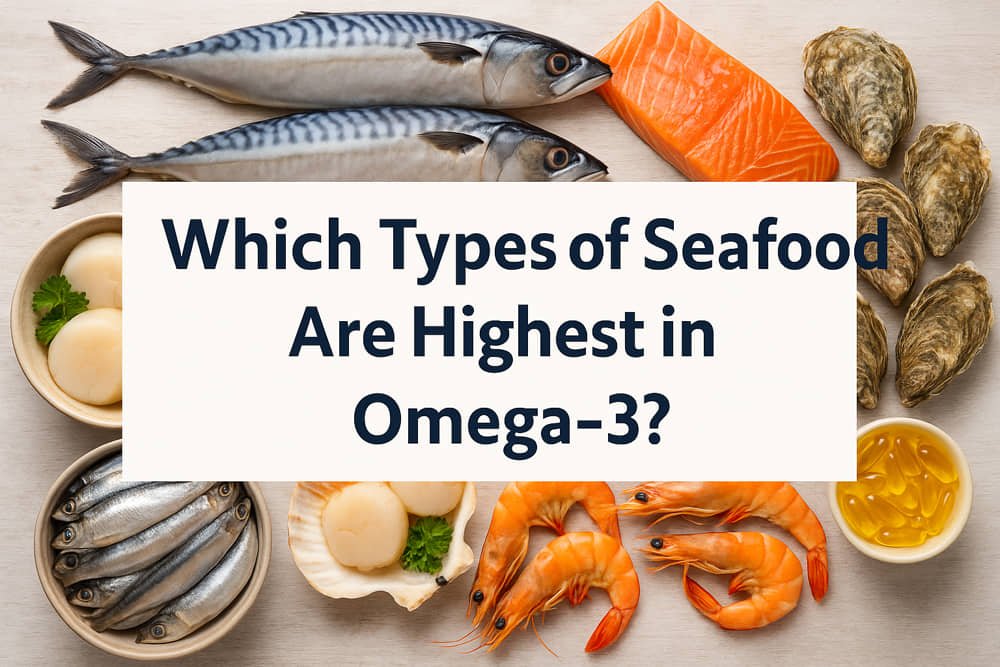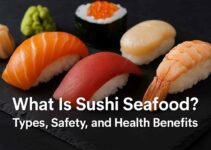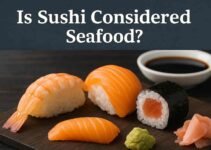Omega-3 fatty acids are among the most scientifically validated nutrients for maintaining overall health, particularly in supporting heart function, reducing inflammation, and promoting optimal brain performance. While omega-3 supplements are widely available, research consistently shows that the most effective and bioavailable form of these essential fatty acids comes directly from natural food sources—specifically seafood.
But with a wide variety of fish and shellfish available at markets and restaurants, it’s crucial to know which types provide the highest concentrations of omega-3. This knowledge ensures you’re not just eating seafood for its flavor, but also maximizing its nutritional impact.
In this comprehensive guide, we’ll explore the exact seafood types richest in omega-3 fatty acids, backed by authoritative nutritional data. You’ll discover how different species compare in omega-3 content, why the form of omega-3 in seafood is superior to plant-based alternatives, and how cooking methods can influence its nutritional value. Whether your goal is to improve heart health, support cognitive function, or meet recommended dietary guidelines, this guide will help you make informed, health-optimized choices.
Contents
- 1 What Makes Seafood an Excellent Source of Omega-3 Fatty Acids?
- 2 Which Fish Have the Highest Omega-3 Content per Serving?
- 3 Are Shellfish Also High in Omega-3 Fatty Acids?
- 4 What Cooking Methods Help Preserve Omega-3 in Seafood?
- 5 How Often Should You Eat High Omega-3 Seafood for Health Benefits?
- 6 Are There Risks Associated with Eating High Omega-3 Seafood?
- 7 What Are the Best Sustainable Sources of High Omega-3 Seafood?
What Makes Seafood an Excellent Source of Omega-3 Fatty Acids?
Seafood stands out as the most potent source of long-chain omega-3 fatty acids—primarily eicosapentaenoic acid (EPA) and docosahexaenoic acid (DHA). These forms are directly utilized by the human body, offering faster and more effective health benefits compared to the plant-based alpha-linolenic acid (ALA).
Studies published in the Journal of Nutrition confirm that EPA and DHA from seafood contribute significantly to reducing triglyceride levels, lowering the risk of arrhythmias, and preventing plaque formation in arteries. Additionally, these fatty acids play a critical role in supporting brain health, particularly in aging populations where cognitive decline is a concern.
Which Types of Omega-3 Are Found in Seafood? (EPA, DHA, and ALA Explained)
Seafood primarily provides two key omega-3 fatty acids:
- EPA (Eicosapentaenoic Acid): Known for its anti-inflammatory properties and cardiovascular benefits.
- DHA (Docosahexaenoic Acid): Essential for brain health, vision, and neurological development.
Unlike plant-based sources like flaxseed or chia seeds that contain ALA, the human body converts only about 5% of ALA into usable EPA and DHA. This makes direct consumption of EPA and DHA from seafood far more efficient for meeting your nutritional needs.
Why Is Omega-3 from Seafood More Effective Than Plant-Based Sources?
The bioavailability of omega-3 from seafood is significantly higher than from plant-based sources. While you would need to consume over 30 grams of flaxseed oil to match the EPA and DHA content found in one serving of salmon (about 3.5 ounces or 100 grams), seafood delivers these fatty acids in their most absorbable form.
Additionally, seafood provides supporting nutrients like vitamin D, selenium, and high-quality protein, creating a synergistic effect that enhances omega-3 absorption and utilization. For individuals aiming to improve cardiovascular and cognitive health, incorporating seafood directly into the diet remains the most efficient strategy.
Which Fish Have the Highest Omega-3 Content per Serving?
Not all fish are created equal when it comes to omega-3 content. Cold-water, oily fish tend to have the highest concentrations of EPA and DHA. Consuming these varieties ensures that even small servings deliver significant health benefits.
According to the USDA FoodData Central, the following fish provide the highest omega-3 content per 100-gram serving:
- Mackerel: Approximately 5,134 mg of omega-3.
- Salmon (Wild-Caught): Around 2,260 mg of omega-3.
- Sardines (Canned in Oil): About 2,205 mg of omega-3.
- Anchovies: Roughly 2,113 mg of omega-3.
- Herring: Around 1,885 mg of omega-3.
Including these fish in your weekly diet significantly contributes to meeting the recommended intake of 250–500 mg of combined EPA and DHA per day.
How Much Omega-3 Is in Salmon Compared to Other Fish?
Wild-caught salmon offers one of the highest and cleanest sources of omega-3 fatty acids, providing about 2,260 mg per 100 grams. In comparison, farmed salmon may contain slightly higher fat but often lower omega-3 density due to altered diets.
When comparing salmon to mackerel, the latter surpasses with over 5,000 mg of omega-3 per 100 grams, making it the most concentrated source. However, mackerel also tends to have higher mercury levels, especially in larger species like king mackerel, so moderation is advised.
Are Mackerel and Sardines Richer in Omega-3 Than Tuna?
Yes, both mackerel and sardines contain significantly more omega-3 per serving than most types of tuna. While light canned tuna provides about 500 mg of omega-3 per 100 grams, sardines and mackerel easily offer four to ten times that amount.
Additionally, sardines are low in mercury and rich in calcium when consumed with bones, making them a highly nutritious and safer choice for regular consumption. Tuna, particularly larger species like albacore and yellowfin, should be consumed in moderation due to higher mercury content.
Is Wild-Caught or Farmed Fish Higher in Omega-3?
Wild-caught fish generally have higher levels of omega-3 per calorie, as their natural diets consist of omega-rich marine organisms. Farmed fish, on the other hand, may contain more overall fat but not necessarily a higher concentration of beneficial EPA and DHA.
For example, farmed salmon can have up to 30% more total fat, but a portion of that comes from less beneficial omega-6 fatty acids. If optimizing for omega-3 quality and purity, wild-caught options remain superior.
Are Shellfish Also High in Omega-3 Fatty Acids?
While fish often take center stage in omega-3 discussions, certain shellfish are also valuable sources of these essential fatty acids. Though their omega-3 content is generally lower than that of oily fish, shellfish offer additional nutritional benefits, including high-quality protein, zinc, iron, and vitamin B12.
Incorporating shellfish like oysters, mussels, and scallops into your diet can help diversify your omega-3 intake while providing a rich array of micronutrients that support overall health.
How Do Oysters and Mussels Compare in Omega-3 Content?
Oysters and mussels are among the most nutrient-dense shellfish available and provide meaningful amounts of omega-3.
- Oysters: Contain approximately 600 mg of omega-3 per 100 grams.
- Mussels: Provide about 500–600 mg of omega-3 per 100 grams.
In addition to their omega-3 content, oysters are exceptionally high in zinc, supporting immune health and hormone regulation. Mussels contribute significant levels of vitamin B12, which is essential for red blood cell production and neurological function.
Both oysters and mussels are also considered environmentally sustainable seafood choices, making them ideal for health-conscious and eco-conscious consumers.
Do Scallops and Shrimp Provide Meaningful Amounts of Omega-3?
Scallops and shrimp contain lower amounts of omega-3 compared to oysters and mussels, but they can still contribute to your daily intake when consumed regularly.
- Scallops: Offer around 200–300 mg of omega-3 per 100 grams.
- Shrimp: Contain approximately 250 mg of omega-3 per 100 grams.
Though their omega-3 content is modest, both scallops and shrimp are excellent sources of lean protein and essential minerals such as selenium and iodine.
However, it’s important to select wild-caught or responsibly farmed shrimp to avoid issues related to unsustainable fishing practices and antibiotic use in aquaculture.
What Cooking Methods Help Preserve Omega-3 in Seafood?
The way seafood is prepared has a direct impact on its omega-3 content. Heat, cooking time, and the type of fat used during cooking can either preserve or degrade these beneficial fatty acids. To retain the highest nutritional value, it’s essential to choose cooking methods that minimize oxidation and prevent the breakdown of delicate omega-3 compounds.
Does Frying Reduce Omega-3 Content Significantly?
Yes, frying is one of the least favorable methods for preserving omega-3 fatty acids. High cooking temperatures—often above 180°C (356°F)—cause oxidation of EPA and DHA, reducing their potency. Additionally, the type of oil used for frying can further diminish the health value of seafood.
For example, frying salmon can result in a loss of up to 70% of its original omega-3 content, especially if vegetable oils high in omega-6 fatty acids are used. Repeated use of frying oil exacerbates this effect, leading to the formation of harmful trans fats. If frying is preferred, using stable oils like avocado oil and keeping temperatures moderate can help reduce omega-3 degradation, but steaming or baking remain healthier alternatives.
Is Raw or Lightly Cooked Seafood Better for Omega-3 Retention?
Yes, consuming seafood raw or lightly cooked is highly effective for preserving omega-3 fatty acids. Raw preparations such as sashimi, crudo, and ceviche maintain nearly all of the original EPA and DHA content.
Light cooking methods such as steaming, poaching, or baking at low temperatures (below 160°C or 320°F) also preserve a significant portion of omega-3. For example, steaming salmon retains over 90% of its omega-3 content, making it one of the most nutrient-preserving options.
If consuming raw seafood, ensure it is of high quality and properly handled to reduce the risk of foodborne illness. Opt for sushi-grade products or purchase from reputable sources specializing in fresh, high-quality seafood.
How Often Should You Eat High Omega-3 Seafood for Health Benefits?
To fully benefit from the cardiovascular, cognitive, and anti-inflammatory advantages of omega-3 fatty acids, regular consumption of high omega-3 seafood is recommended. Health organizations, including the American Heart Association (AHA), suggest consuming at least two servings (about 200–250 grams) of oily fish per week. This equates to approximately 500 mg of combined EPA and DHA daily for the average adult.
However, individual needs may vary based on health conditions. For instance, individuals with high triglycerides or inflammatory disorders may benefit from even higher intakes under medical supervision. Children and pregnant women should also prioritize omega-3 intake, particularly DHA, for optimal brain and vision development, but must be cautious of mercury exposure.
What Is the Recommended Weekly Intake of Omega-3 for Adults and Children?
- Adults: The recommended intake is 250–500 mg of EPA and DHA per day, ideally obtained through natural food sources rather than supplements.
- Children (1–8 years): Require 100–150 mg per day, supporting healthy brain development and immune function.
- Pregnant and Breastfeeding Women: Should aim for 300–900 mg of DHA per day, critical for fetal and infant neural development.
Meeting these levels can be achieved by incorporating omega-3 rich seafood like salmon, sardines, and mackerel into weekly meal plans. For those unable to consume seafood regularly, high-quality fish oil supplements can be considered as an alternative, but whole food sources are preferred for their synergistic nutrient profile.
Can You Get Too Much Omega-3 from Eating Seafood Frequently?
While omega-3 fatty acids are essential for health, excessive intake—particularly through high-dose supplements—can lead to negative effects such as blood thinning, increased bleeding risk, and suppressed immune response.
However, reaching harmful levels through diet alone is highly unlikely. The more pressing concern with frequent seafood consumption is mercury and heavy metal exposure, especially from large predatory fish like swordfish, shark, and king mackerel.
To balance benefits and risks:
- Prioritize low-mercury, high-omega-3 species like salmon, sardines, anchovies, and herring.
- Limit high-mercury fish to no more than one serving per month if consumed at all.
- Diversify seafood intake to reduce toxic build-up while maintaining consistent omega-3 consumption.
Are There Risks Associated with Eating High Omega-3 Seafood?
While consuming seafood is one of the most effective ways to boost omega-3 intake, it is essential to consider potential health risks associated with certain types of seafood. The primary concerns include mercury contamination, exposure to other heavy metals like cadmium and lead, and the accumulation of environmental toxins such as polychlorinated biphenyls (PCBs).
Understanding which seafood species present higher risks allows you to make safer dietary decisions without sacrificing the nutritional benefits of omega-3 fatty acids.
Which High Omega-3 Fish Are Also High in Mercury?
Several fish species that are rich in omega-3 also rank high on the mercury contamination scale. These include:
- King Mackerel
- Shark
- Swordfish
- Tilefish (from the Gulf of Mexico)
- Bigeye Tuna
These large, predatory fish accumulate mercury over time due to their longer lifespans and higher positions in the food chain. Consuming them frequently increases the risk of mercury poisoning, which is particularly dangerous for pregnant women, young children, and individuals with compromised kidney function.
For safer choices, opt for fish like salmon, sardines, herring, and anchovies, which are both high in omega-3 and low in mercury.
How Can You Safely Balance Omega-3 Intake and Mercury Exposure?
To enjoy the health benefits of omega-3 without the risks of mercury toxicity:
- Prioritize Low-Mercury Fish: Focus on smaller, short-lived species such as sardines, anchovies, herring, and wild-caught salmon.
- Follow Government Guidelines: Agencies like the FDA and EPA recommend limiting consumption of high-mercury fish to no more than once per month.
- Diversify Seafood Sources: Rotate between different low-mercury species to avoid overexposure to any single contaminant.
- Consider Certified Sustainable Sources: Look for seafood certified by organizations like MSC (Marine Stewardship Council), which ensures responsible harvesting and lower environmental contaminant levels.
What Are the Best Sustainable Sources of High Omega-3 Seafood?
Sustainability is a growing concern among consumers aiming to protect both their health and the environment. Overfishing and unsustainable aquaculture practices contribute to habitat destruction, declining fish populations, and increased toxin levels in seafood. Choosing sustainable sources of high omega-3 seafood not only supports ocean ecosystems but also often results in cleaner, healthier fish.
Which Seafood Options Are Certified Sustainable and Omega-3 Rich?
The following seafood options strike an excellent balance between sustainability and high omega-3 content:
- Wild Alaskan Salmon (MSC Certified)
- Pacific Sardines (MSC Certified)
- Atlantic Mackerel (Certified by Friend of the Sea)
- Farmed Mussels and Oysters (Low environmental impact and high nutrient density)
Organizations like the Marine Stewardship Council (MSC) and Aquaculture Stewardship Council (ASC) provide certifications for seafood that meet strict environmental and sustainability criteria. Always look for these labels when purchasing seafood.
How Can You Identify Eco-Friendly Omega-3 Seafood at Markets?
- Check for Certification Labels: Look for trusted certifications such as MSC, ASC, or Friend of the Sea on packaging.
- Use Sustainable Seafood Guides: Resources like the Monterey Bay Aquarium’s Seafood Watch app offer real-time recommendations for sustainable choices based on your location.
- Buy from Reputable Retailers: Supermarkets and fishmongers committed to sustainable sourcing typically display clear labeling and offer detailed information about their products’ origins.
By consciously selecting sustainable seafood options, you not only protect your health but also contribute to the long-term preservation of marine life.
Incorporating omega-3-rich seafood into your diet is a proven, science-backed approach to enhancing heart health, cognitive function, and overall well-being. By focusing on species such as wild-caught salmon, sardines, mackerel, and oysters, you ensure a concentrated intake of the most beneficial forms of omega-3—EPA and DHA—while minimizing exposure to harmful contaminants like mercury and PCBs. Opting for MSC-certified wild-caught fish and low-impact shellfish like mussels and oysters also contributes to sustainable seafood practices, helping to protect marine ecosystems for future generations. Small, conscious dietary choices today not only improve personal health but also support global sustainability efforts. To further explore the health benefits of eating seafood, check out our detailed guide.



